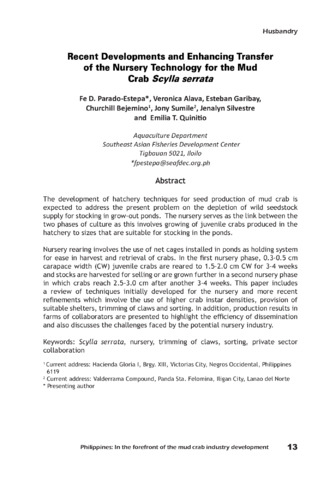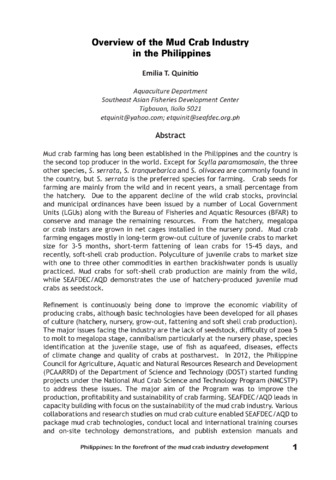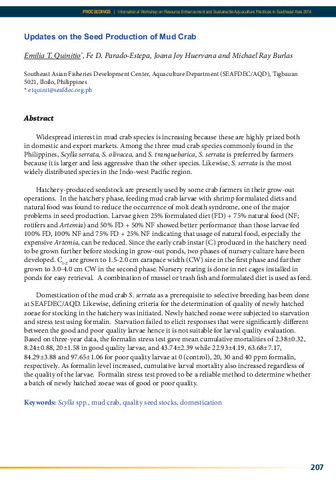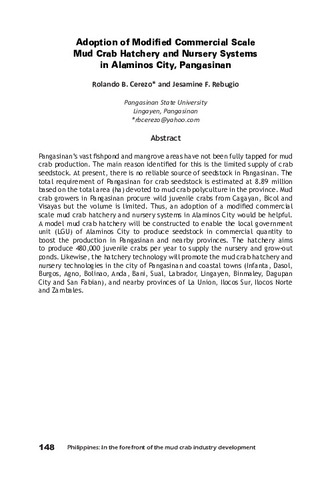Recent developments and enhancing transfer of the nursery technology for the mud crab Scylla serrata
Share
Abstract
The development of hatchery techniques for seed production of mud crab is expected to address the present problem on the depletion of wild seedstock supply for stocking in grow-out ponds. The nursery serves as the link between the two phases of culture as this involves growing of juvenile crabs produced in the hatchery to sizes that are suitable for stocking in the ponds.Nursery rearing involves the use of net cages installed in ponds as holding system for ease in harvest and retrieval of crabs. In the first nursery phase, 0.3-0.5 cm carapace width (CW) juvenile crabs are reared to 1.5-2.0 cm CW for 3-4 weeks and stocks are harvested for selling or are grown further in a second nursery phase in which crabs reach 2.5-3.0 cm after another 3-4 weeks. This paper includes a review of techniques initially developed for the nursery and more recent refinements which involve the use of higher crab instar densities, provision of suitable shelters, trimming of claws and sorting. In addition, production results in farms of collaborators are presented to highlight the efficiency of dissemination and also discusses the challenges faced by the potential nursery industry.
Suggested Citation
Parado-Estepa, F. D., Alava, V. R., Garibay, E., Bejemino, C., Sumile, J., Silvestre, J., & Quinitio, E. T. (2017). Recent developments and enhancing transfer of the nursery technology for the mud crab Scylla serrata. In E. T. Quinitio, F. D. Parado-Estepa, & R. M. Coloso (Eds.), Philippines : In the forefront of the mud crab industry development : proceedings of the 1st National Mud Crab Congress, 16-18 November 2015, Iloilo City, Philippines (pp. 13-21). Tigbauan, Iloilo, Philippines: Aquaculture Department, Southeast Asian Fisheries Development Center.
Subject
Taxonomic term
Related items
Showing items related by title, author, creator and subject.
-
Overview of the mud crab industry in the Philippines
Quinitio, Emilia T. (Aquaculture Department, Southeast Asian Fisheries Development Center, 2017)Mud crab farming has long been established in the Philippines and the country is the second top producer in the world. Except for Scylla paramamosain, the three other species, S. serrata, S. tranquebarica and S. olivacea ... -
Updates on the seed production of mud crab
Quinitio, Emilia T.; Parado-Estepa, Fe D.; Huervana, Joana Joy; Burlas, Michael Ray (Aquaculture Department, Southeast Asian Fisheries Development Center, 2015)Widespread interest in mud crab species is increasing because these are highly prized both in domestic and export markets. Among the three mud crab species commonly found in the Philippines, Scylla serrata, S. olivacea, ... -
Adoption of modified commercial scale mud crab hatchery and nursery systems in Alaminos City, Pangasinan
Cerezo, Rolando B.; Rebugio, Jesamine F. (Aquaculture Department, Southeast Asian Fisheries Development Center, 2017)Pangasinan’s vast fishpond and mangrove areas have not been fully tapped for mud crab (Scylla serrata) production. The main reason identified for this is the limited supply of crab seedstock. At present, there is no reliable ...






